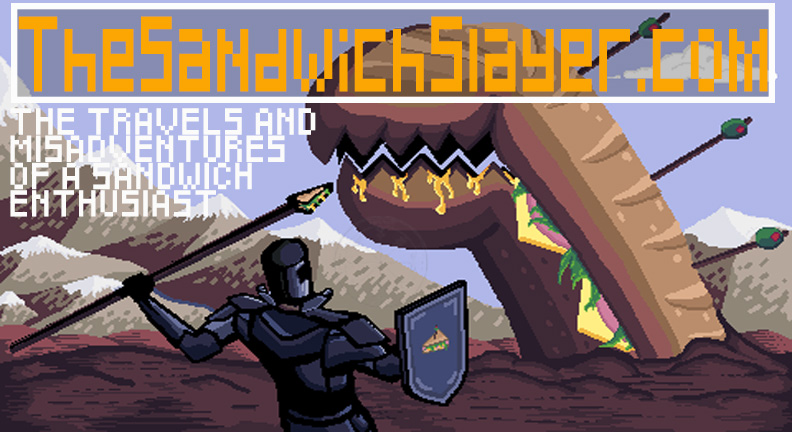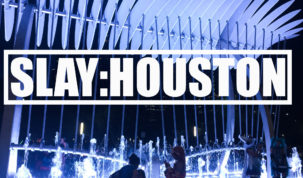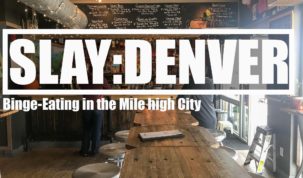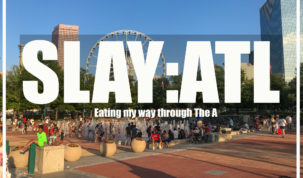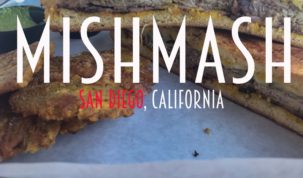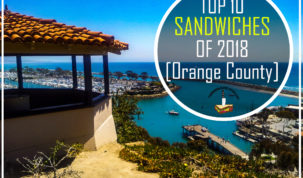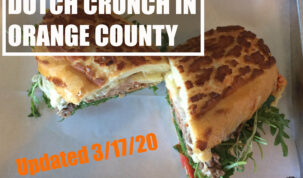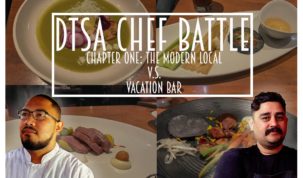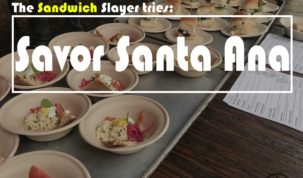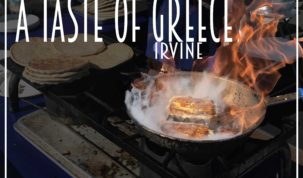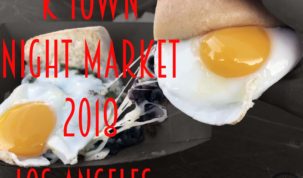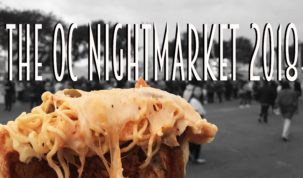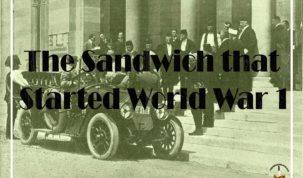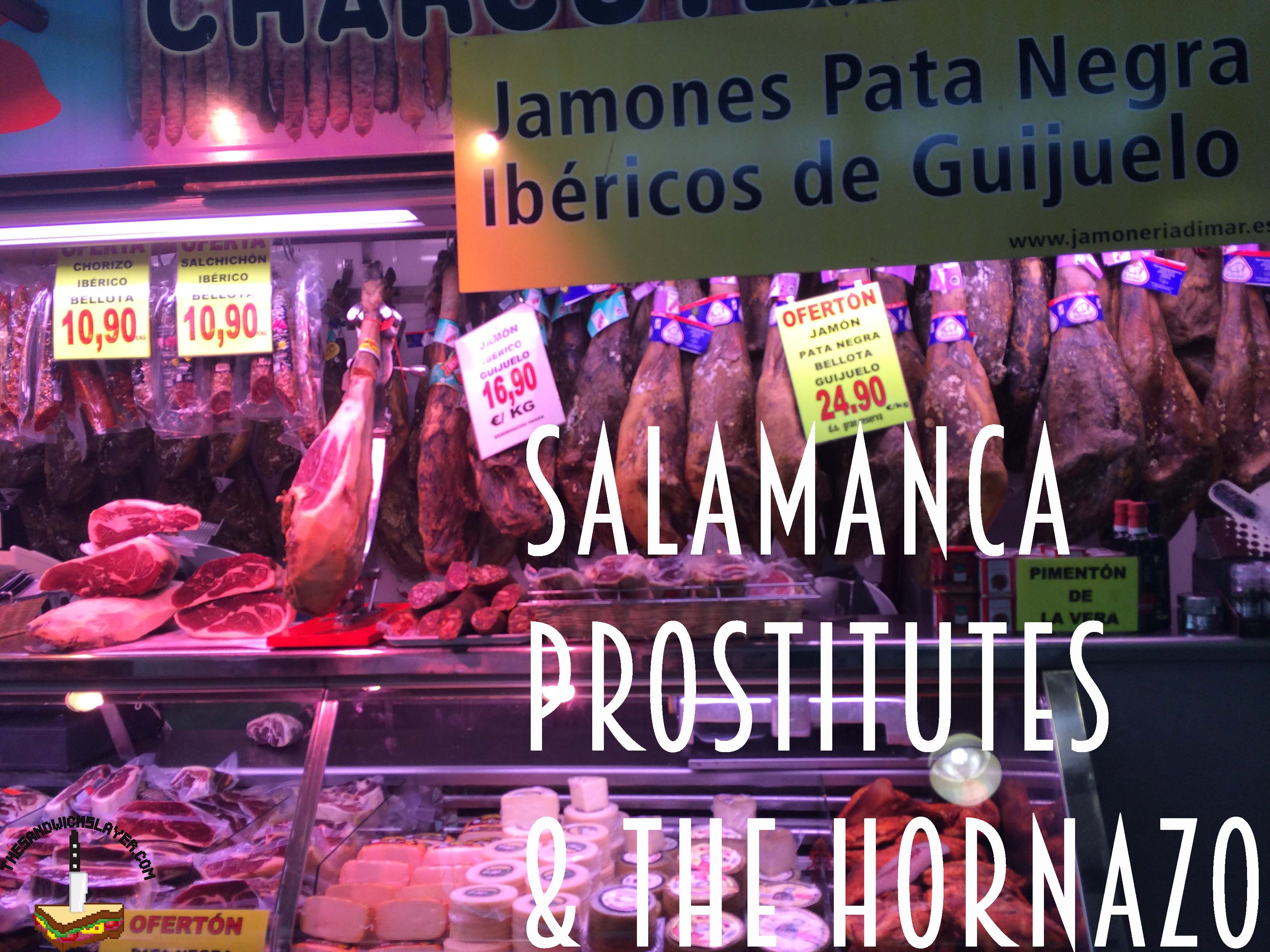I woke up early today and I headed toward a museum to try something called a “Wally” tour, a 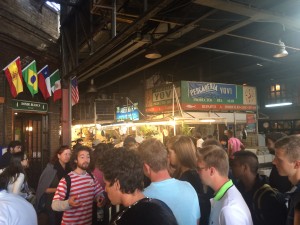 daily walking tour of Santiago that works solely on tips, and I am really glad that I did. I am here in Chile on my own, with nothing really planned other than meandering about, so to find out about a city tour that doesn’t require any planning that you can just show up for is really great. I took an “off the beaten path” tour where we walked around areas that are not the standard parts of a city tour (like going to political buildings, city monuments, or tourist attractions). I settled in with 15 other random people from across the city and we began to embark on a learning experience about some of the most fundamental parts of Chilean life. I couldn’t help but think of my late friend Eddy during this walk, and you’ll find out why later.
daily walking tour of Santiago that works solely on tips, and I am really glad that I did. I am here in Chile on my own, with nothing really planned other than meandering about, so to find out about a city tour that doesn’t require any planning that you can just show up for is really great. I took an “off the beaten path” tour where we walked around areas that are not the standard parts of a city tour (like going to political buildings, city monuments, or tourist attractions). I settled in with 15 other random people from across the city and we began to embark on a learning experience about some of the most fundamental parts of Chilean life. I couldn’t help but think of my late friend Eddy during this walk, and you’ll find out why later.
The local market has always been a source for inspiration for me. It provides an insight into the local food culture and gives you an idea of 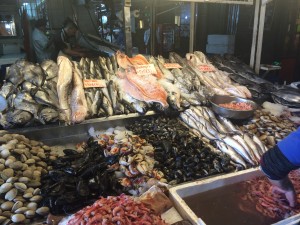 what people are really eating in town. There is a certain energy inside the market that I rarely ever find back in Southern California, it’s complete chaos that runs to it’s own uniform beat. Really the feeling is indescribable, I think I am so used to American supermarkets where everything is so sterile that I get excited to experience marketplaces.
what people are really eating in town. There is a certain energy inside the market that I rarely ever find back in Southern California, it’s complete chaos that runs to it’s own uniform beat. Really the feeling is indescribable, I think I am so used to American supermarkets where everything is so sterile that I get excited to experience marketplaces.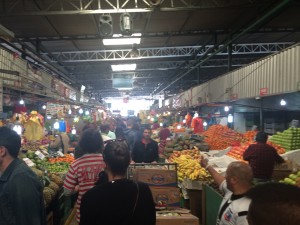 It took me back to the medinas of Morocco, where the dance between merchant and patron had the potential to change fortunes quickly. As we went through the meat market, the girls got offers for marriage in between the sounds of deal making and advertisement while the guys strolled through with little trouble outside of a pushcart filled with fish blocking the way on occasion. We walk across the way into the La Vega Central Market, an iconic market in the Recoleta commune, near the Mapocho river.
It took me back to the medinas of Morocco, where the dance between merchant and patron had the potential to change fortunes quickly. As we went through the meat market, the girls got offers for marriage in between the sounds of deal making and advertisement while the guys strolled through with little trouble outside of a pushcart filled with fish blocking the way on occasion. We walk across the way into the La Vega Central Market, an iconic market in the Recoleta commune, near the Mapocho river. 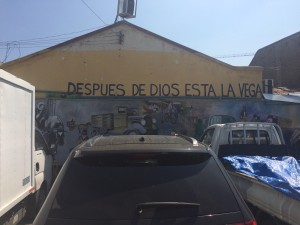 Famed poet Pablo Neruda came to this market, and the merchants sat on fruit crates to hear him read poetry and tell tales of the Spanish civil war, adding to the fame of the market. To this day, La Vega has a certain spirit to it that cannot quite be explained, I felt it when I walked the stalls. From what would be considered simple farmers and merchants selling their food you see pride beaming and spirits high. That maybe why their motto is “Despues De Dios esta La Vega” which means “After God, there is La Vega” a bold and symbolic assurance that after God, this market will always provide for its people.
Famed poet Pablo Neruda came to this market, and the merchants sat on fruit crates to hear him read poetry and tell tales of the Spanish civil war, adding to the fame of the market. To this day, La Vega has a certain spirit to it that cannot quite be explained, I felt it when I walked the stalls. From what would be considered simple farmers and merchants selling their food you see pride beaming and spirits high. That maybe why their motto is “Despues De Dios esta La Vega” which means “After God, there is La Vega” a bold and symbolic assurance that after God, this market will always provide for its people.
We left the chaos and shuffle of the La Vega Market to enter the quiet hallowed grounds of the Cementerio General de Santiago. 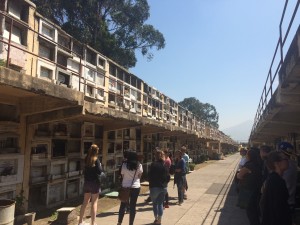 Walking through the large iron gates we found ourselves in a silent city, where the residences in their quiet solitude welcomed us. In their own way they reminded us that it didn’t matter our station in life, we all are equal in the end. The long rows of graves on top of each other was something that I haven’t seen before, it was like being in a completely different (and more somber) neighborhood in Santiago, where a buildings and residences defined the boundaries and a distinct culture rose from those borders. From the most basic of graves we walked the streets to the Mausoleums of Santiago’s upper class, where even in death people look to show off their wealth (even when they can’t take it with them). Chile’s first elected Marxist leader Salvador Allende is buried here, along with some of Santiago’s most famous dead. Huge mausoleums are built for the officers of the city, the cobblers,
Walking through the large iron gates we found ourselves in a silent city, where the residences in their quiet solitude welcomed us. In their own way they reminded us that it didn’t matter our station in life, we all are equal in the end. The long rows of graves on top of each other was something that I haven’t seen before, it was like being in a completely different (and more somber) neighborhood in Santiago, where a buildings and residences defined the boundaries and a distinct culture rose from those borders. From the most basic of graves we walked the streets to the Mausoleums of Santiago’s upper class, where even in death people look to show off their wealth (even when they can’t take it with them). Chile’s first elected Marxist leader Salvador Allende is buried here, along with some of Santiago’s most famous dead. Huge mausoleums are built for the officers of the city, the cobblers,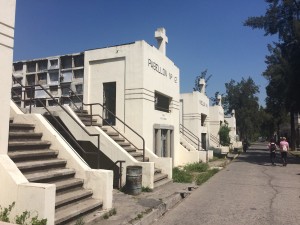 even the clowns. There is also a house for Spanish nationalists along with a rather large and morbid apartment building-like structure for the Italian residences of Santiago. Somewhere amongst the rows of Santiago’s citizens is the small grave of a child named Romauldito. What makes Romauldito special is that he has become an animita, a local folk saint. In 1930, the young Romauldito was working at the entrance of the Santiago bus station when he was accosted by several attackers and was fatally stabbed. He was so well loved by the people of the city that they erected a shrine at the bus station and people would leave flowers and candles in his honor. As time went on, people began posting notes on his shrine and grave thanking him for the miracles that he performed, turning him into a city saint Romauldito
even the clowns. There is also a house for Spanish nationalists along with a rather large and morbid apartment building-like structure for the Italian residences of Santiago. Somewhere amongst the rows of Santiago’s citizens is the small grave of a child named Romauldito. What makes Romauldito special is that he has become an animita, a local folk saint. In 1930, the young Romauldito was working at the entrance of the Santiago bus station when he was accosted by several attackers and was fatally stabbed. He was so well loved by the people of the city that they erected a shrine at the bus station and people would leave flowers and candles in his honor. As time went on, people began posting notes on his shrine and grave thanking him for the miracles that he performed, turning him into a city saint Romauldito 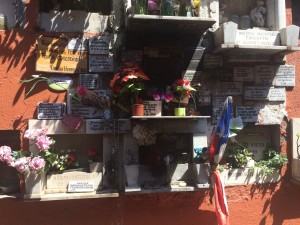 soon became a fixture of the city, a beacon for people in need and a focus of scorn for the Catholic mayor of the city. In an attempt to rid his shrine of idolaters, the mayor sent an officer to remove the shrine to Romauldito in the middle of the night with little success. The horse, while stepping closer to the shrine bucked the officer off and killed him. Even to this day, the bus station still has that piece of the wall (even though the rest of the station has been renovated) where the shrine lays, construction workers being to scared of Romauldito and his power. Whether you choose to believe or not, the love and veneration showered upon this young man by the people of the city is a sight to see. The understanding and processing of death is always an interesting cultural experience.
soon became a fixture of the city, a beacon for people in need and a focus of scorn for the Catholic mayor of the city. In an attempt to rid his shrine of idolaters, the mayor sent an officer to remove the shrine to Romauldito in the middle of the night with little success. The horse, while stepping closer to the shrine bucked the officer off and killed him. Even to this day, the bus station still has that piece of the wall (even though the rest of the station has been renovated) where the shrine lays, construction workers being to scared of Romauldito and his power. Whether you choose to believe or not, the love and veneration showered upon this young man by the people of the city is a sight to see. The understanding and processing of death is always an interesting cultural experience.
As I exited the gate of the cemetery I took a moment to reflect on some moments in my life (there are few things that’ll make you think about life more than facing death) and I was reminded of my friend, the late Eddy Gutierrez who was 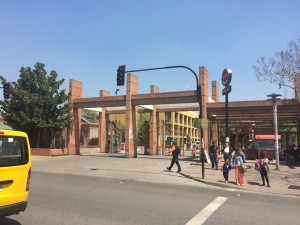 deeply involved in the Afro-Cuban religion Lucumi (Santeria). Over a long talk about life and spirit he told me about an Orisha named Oya, a female warrior Goddess who lives in the marketplace and tends the cemetery gates. according to Eddy’s site, “she escorts the spirits of the dead to the threshold of the graveyard.” and ” is the force of change in nature and in life.” It seems only fitting that this trip is a transformative one for me and that Eddy’s words and spirits would follow me to South America, it’s oddly comforting to think that maybe he still observes the things I do in my life. In my mind this day was a tribute to him (as well as Oya) a welcomed epiphany after a beer in the Barrio Bellevista that night. The cherry on top was my server that night introduced himself, and told me that we’re going to be friends very soon because he is Cuban, and the embargo is being lifted soon. Coincidence it may be to you, but to me it’s all part of the magic that is our world. Cheers my dear friends, and rise in power.
deeply involved in the Afro-Cuban religion Lucumi (Santeria). Over a long talk about life and spirit he told me about an Orisha named Oya, a female warrior Goddess who lives in the marketplace and tends the cemetery gates. according to Eddy’s site, “she escorts the spirits of the dead to the threshold of the graveyard.” and ” is the force of change in nature and in life.” It seems only fitting that this trip is a transformative one for me and that Eddy’s words and spirits would follow me to South America, it’s oddly comforting to think that maybe he still observes the things I do in my life. In my mind this day was a tribute to him (as well as Oya) a welcomed epiphany after a beer in the Barrio Bellevista that night. The cherry on top was my server that night introduced himself, and told me that we’re going to be friends very soon because he is Cuban, and the embargo is being lifted soon. Coincidence it may be to you, but to me it’s all part of the magic that is our world. Cheers my dear friends, and rise in power.
-Vy
